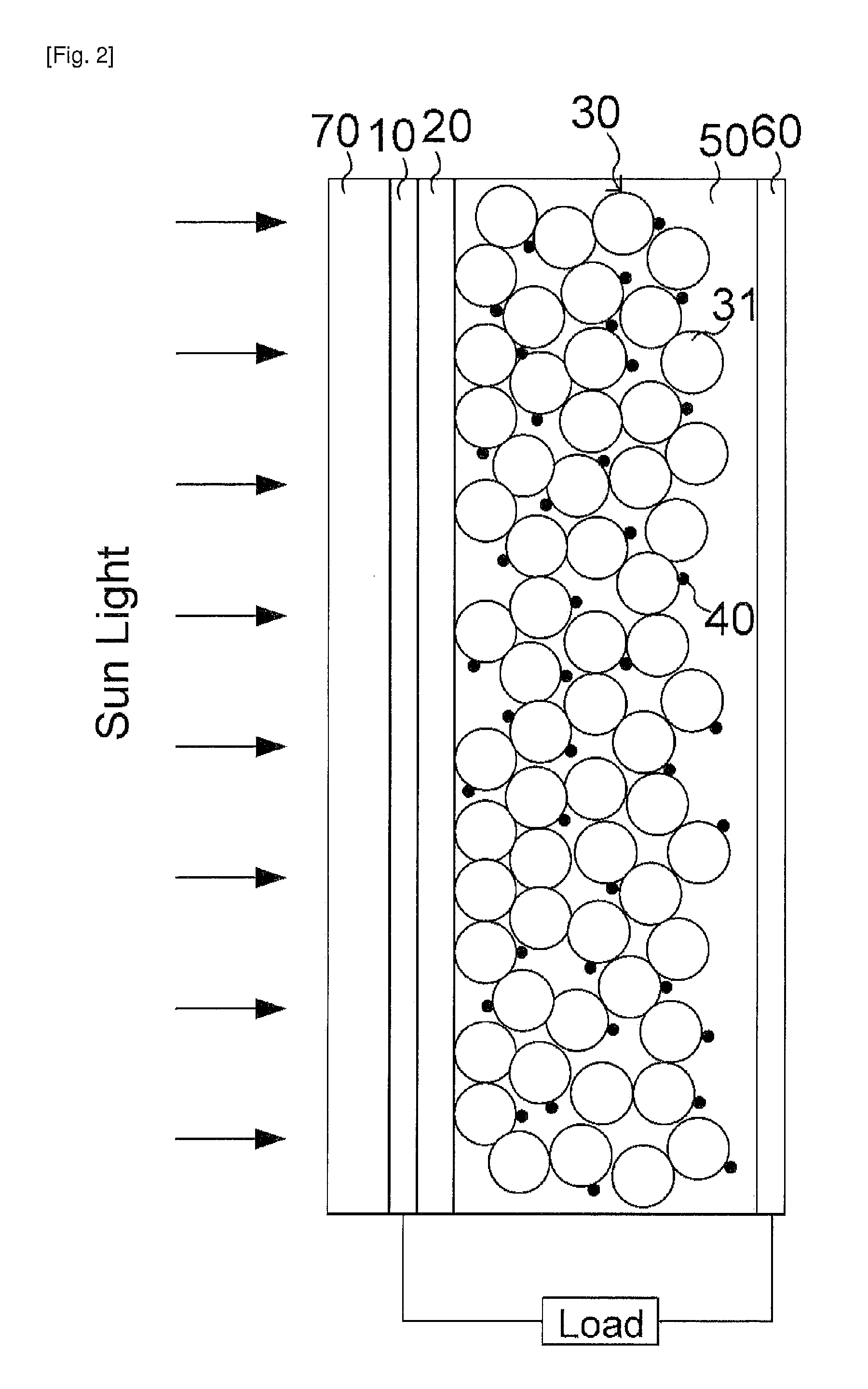Method for Manufacturing a Nanostructured Inorganic/Organic Heterojunction Solar Cell
a solar cell and nano-organic technology, applied in the direction of solid-state devices, sustainable manufacturing/processing, final product manufacturing, etc., can solve the problems of stability, blockage of large-scale use of solar cells, and low manufacturing cost of solar cells, so as to facilitate the treatment of them and improve energy conversion efficiency
- Summary
- Abstract
- Description
- Claims
- Application Information
AI Technical Summary
Benefits of technology
Problems solved by technology
Method used
Image
Examples
preparing example 1
[0129]After a glass substrate on which tin oxide containing fluorine (first electrode) is coated (fluorine-doped F-substrate) was cut at a size of 25×25 mm, end portions thereof were etched to partially remove FTO, similarly to FIG. 5.
[0130]A dense structured TiO2 thin film having a thickness of 50 nm was prepared by a spray pyrolysis method (SPM) on the cut and partially etched FTO substrate as a recombination preventing film. The SPM was performed using a titanium acetylacetonate (TAA): EtOH(1:9v / v %) solution, and a thickness was controlled by repeating a method of spraying the solution for 3 seconds and stopping for 10 seconds on the FTO substrate positioned on a hot plate maintained at a temperature of 450° C.
[0131]5 ml of ethyl cellulose solution in which 10 weight % of ethyl cellulose is dissolved in ethyl alcohol was added to TiO2 powder having an average particle size of 60 nm (preparing by hydrothermal treatment of titanium perocomplex aqueous solution in which 1% is disso...
preparing example 2
[0136]After a glass substrate on which tin oxide containing fluorine (first electrode) is coated (fluorine-doped F-doped SnO2, 8 ohms / sq, Pilkington, hereinafter, FTO substrate) was cut at a size of 25×25 mm, end portions thereof were etched to partially remove FTO similarly to FIG. 5.
[0137]A dense structured TiO2 thin film having a thickness of about 50 nm was prepared by a spray pyrolysis method (SPM) on the cut and partially etched FTO substrate as a recombination preventing film. The SPM was performed using a titanium acetylacetonate (TAA):EtOH(1:9v / v %) solution, and a thickness was controlled by repeating a method of spraying the solution for 3 seconds and stopping for 10 seconds on the FTO substrate positioned on a hot plate maintained at a temperature of 450° C.
[0138]5 ml of ethyl cellulose solution in which 10 weight % of ethyl cellulose is dissolved in ethyl alcohol was added to TiO2 powder having an average particle size of 60 nm (preparing by hydrothermal treatment of ti...
PUM
| Property | Measurement | Unit |
|---|---|---|
| particle size | aaaaa | aaaaa |
| specific surface area | aaaaa | aaaaa |
| thickness | aaaaa | aaaaa |
Abstract
Description
Claims
Application Information
 Login to View More
Login to View More - R&D
- Intellectual Property
- Life Sciences
- Materials
- Tech Scout
- Unparalleled Data Quality
- Higher Quality Content
- 60% Fewer Hallucinations
Browse by: Latest US Patents, China's latest patents, Technical Efficacy Thesaurus, Application Domain, Technology Topic, Popular Technical Reports.
© 2025 PatSnap. All rights reserved.Legal|Privacy policy|Modern Slavery Act Transparency Statement|Sitemap|About US| Contact US: help@patsnap.com



